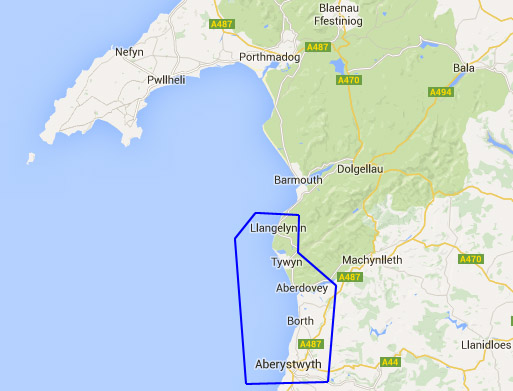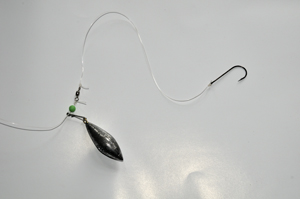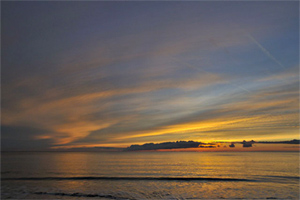| Home | Guided trips | Latest news | The book |
| Fish Species | Essential reading | Contact and booking |
Guided Trips:
what's on offer?
The local area - and beyond...
 The 20-mile
long Aberystwyth-Tywyn stretch of the Cardigan Bay coast
(see map R) has a rich variety of fishing-grounds.
The 20-mile
long Aberystwyth-Tywyn stretch of the Cardigan Bay coast
(see map R) has a rich variety of fishing-grounds. We have beautiful, almost snag-free sandy beaches where bass, rays and flatfish hunt among the surf-tables. Steeper shingle beaches give access to deeper water. Mixed and rough ground offers a challenge but the rewards can be spectacular. Extensive shallow reefs that dry over low tide reward the angler prepared to travel light and who doesn't mind a bit of rock-hopping.
Such a diversity of marine environments not only attracts a wide range of fish and other marine life to this part of Cardigan Bay but also offers plenty of opportunities for anglers keen to get away from the crowds and explore more remote sections of coastline.
I fish right around Cardigan Bay and have done so ever since taking up sea-angling, so I'm quite happy to guide anglers further afield from my main twenty mile section of coast, so long as customers understand that travel time outside of the main area counts as work time.Going down to the Cardigan district or up to Pwllheli therefore equates to a surcharge of £20 on the total fee. Travel time for local marks between Aberystwyth and Tywyn is, in contrast, covered within the overall cost of the trip.
The main difference in terms of fishing is that NW and SW Wales have good deep-water rock-marks where sizeable pollack may be caught. This sort of fishing involves travelling light and using lures from steep rocks, so I would only take those who are fit, agile and who can handle steep scrambles. Such venues are also far more weather-sensitive, needing not only light winds but dry weather and no appreciable sea-swell.
What's swimming around and when?
Hereabouts, the shore fishing season begins in earnest in the spring. From some point in April onwards (it varies from year to year depending on sea temperatures), we see the arrival of the bass, rays and turbot. In most seasons, weather and sea conditions permitting, mackerel (and garfish) are present in good numbers by mid-summer. They come close-in on evening tides during settled weather when they hammer the baitfish, making the water appear to boil in the process. Larger predators feed on them in turn.
July and August see the sand beaches busy with holidaymakers, but we can find peace and quiet along more remote shorelines. This is an ideal time for novices to learn the basics, for visitors to have an explore, for targeting various more obscure shore species and for species-hunts. Autumn sees the beaches quieter again and the fish come back into the surf. Night tides also start to produce whiting, dabs and codling. Some years see an intense, late run of mackerel especially if we get an Indian summer.
The whiting, dabs and codling are present through to the New Year and until early February except in very cold winters. Late February to late March is the quietest time of year and the ideal time to sort out and maintain the tackle. With all such factors in mind, I operate from the middle of April or early May through to late November (into December and beyond if conditions are bearable).
Accessing venues
Getting to the venues is straightforward, and I will meet you there at an arranged time. Anybody booking a trip will be emailed a map with precise directions and information about parking which is either free or a nominal expense at the majority of the locations. Minimising the number of cars by car-sharing is a seriously good plan as it will make parking more straightforward on busy days. Some venues require walking a fair way, over uneven ground, but others are very close to parking. Please let me know your preferences (bearing in mind the easier the access the busier the venue during the main summer holidays). For Llyn Peninsula rock-fishing, the climbers' cafe under the crags at Tremadog is an ideal rendezvous for those unsure of the route down to the marks.
| Some of
the trips on offer Quick taster-sessions for families: 2 hours Cost: £45 per family. Venues: Borth or Tywyn beaches Day/night: Afternoons or evenings (the latter recommended), depending on tides, daylight and weather. Season: April/May through to late autumn. These short sessions are an ideal activity for holidaying families. They are simply about experiencing shore fishing in a relaxed way, without having to work hard to develop the required skills - if you find you like it, that can come later! Ideal, too, for the youngsters as it's not too demanding on a young attention-span! We fish two or three rods, depending on conditions. I look after the stuff like rig selection, baiting up, casting etc and you get to bring in any fish that might come along! I will also point out and tell you about any other marine life that we might see. Tackle and bait are provided as part of this package. Shore fishing: a comprehensive short course for complete beginners: 4 hours Cost: £70 per person, including all tackle and bait. Max. 4 persons. Venues: Between Aberystwyth and Tywyn. Day/night: Daytime through to dusk. Between 1pm and 9pm, depending on tides, daylight and weather. Season: April/May through to late November, December too if weather stays mild.  These trips are more intensive than the taster-sessions and are aimed at people who have decided to give shore fishing a go but who need a few pointers. It can seem that there's a daunting amount of things to learn, but it's not that bad really! Learn about the right tackle to use, how to tie a few critically important knots, how to treat the marine environment responsibly, understanding the basics of the weather and tides and how they can affect the fishing, choosing appropriate rigs, bait selection/presentation and the basics of casting. A lot can be crammed into four hours! We fish venues that can produce a variety of species in daylight, over mostly clean ground with few snags and where long casting skills are not necessary. Beginner-friendly places, in other words. Here, with your own rods and reels or with equipment provided by me, you will learn how to bait-up your rigs, basic casting and how to respond to bites, and about the marine environment and how to work with it. With a maximum of four participants for each course, one-to-one tuition will be possible throughout and by the end you should feel far more confident about giving it a go on your own. Targeting individual species, improving your fishing and exploring the area: bespoke trips Cost: £15 per person per hour plus bait. Travel surcharge applies for venues south of Aberystwyth and north of Tywyn. Max. 4 persons. Venues: Cardigan Bay Coast Day/night: Any time between 2pm and 10pm depending on tides and weather. Season: April/May to late November as tides permit These bespoke trips are for a) anglers who are new to the area and would like to be shown a few popular marks, b) those who have been fishing (including coarse or fly but not sea) but would like to branch out into sea-angling, c) relatively inexperienced sea-anglers who want to improve or develop specific skills or d) those who are seeking to add a certain species to their list. Tackle can be provided but most of you will have your own. Bait can be supplied at cost if required. This part of the Welsh coast is rightly well-known for highly desirable species such as small-eyed rays, bass and turbot but there's a lot more to it than that. The Species page shows just what's possible around here: I even have a greater weever mark, believe it or not! By shore standards the turbot run to a good size. The Welsh record of 10lbs came from the Tywyn area and I've had several in better years in the 4-6lbs range. Smaller specimens in the 1-2lb bracket are reported most years. Both small-eyed and the less frequently seen thornback rays run to double figures, although smaller specimens are most frequently encountered. In 2017, another angler and I caught nine small-eyed rays in a single evening trip. Good-sized bass are caught every year, with spring, early summer and autumn providing the best surf-fishing. Smaller school-bass can be abundant at times. For the small-eyed rays and turbot, both day and night tides produce though you will be relieved to know that I've done just as well in broad daylight as I have by sacrificing an entire night's sleep. Sea-conditions and tactics are far more important. During settled conditions in July and August, the more popular beaches can get very busy. But that's not a problem: there are literally miles of more remote reefs and mixed ground extending from the north of Tywyn to the south of Aberystwyth, so that there is plenty to explore, even at the busiest time of year. Aberystwyth also offers two jetties to fish from when conditions are settled; their bouldery skirts are home to a wide range of species that respond to small baits fished close-in - this is blenny/goby/wrasse country. Mixed ground beaches are well worth fishing: in June 2012 an experimental trip for tope at one such venue, with two of us fishing whole mackerel fillets, yielded a double-figure bass to me. Bull huss are another frequent catch and provide a lot more entertainment than dogfish! Reefs offer interesting and varied ground with deeper water and clean ground within casting range, with the range of species that such ground offers. Closer in, when sea-conditions permit, there is the chance to indulge in the traditional local technique of float-fishing for bass with crab and/or prawn baits, a pleasant method that involves travelling light and keeping on the move. New to Night-fishing? An Introduction: 4 hours  Cost: £60 per person plus bait. 2-4 persons. Venues: Tywyn to Aberdyfi, Borth and Ynyslas, Aberystwyth. Day/night: Evenings into darkness, depending on tides, weather and time of dusk. Season: September, October, November, December and January too if the weather stays mild. If you have done a bit of fishing, know your knots, are happy with your casting but have never fished at night this is for you. Night tides, especially in the autumn and early winter months, are often very productive. Venues have been chosen that produce a range of species in darkness and at various stages of the tide. Expect to catch from the following list: whiting, codling, flounders, dabs and dogfish plus odd bonus species. Don't forget your headtorch, though. We set up before darkness to make things easy - it's worth it for the sunsets! Above: last
light at Tywyn, waiting for the
whiting to appear. They did!
|